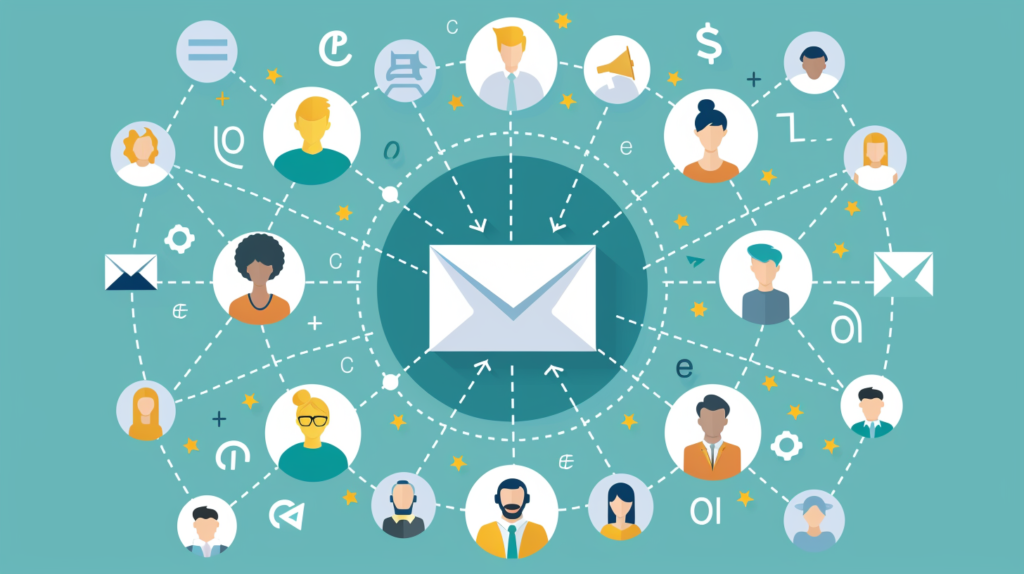
In the ever-evolving world of digital marketing, one thing remains constant: the power of email. But here’s the kicker – not all emails are created equal. Enter email list segmentation, the secret sauce that can transform your email marketing from a shot in the dark to a laser-focused campaign. In this guide, we’ll dive deep into the world of email list segmentation and explore strategies that will skyrocket your engagement rates. Buckle up, marketers – it’s time to segment and conquer!
What is Email List Segmentation?
Before we jump into the nitty-gritty, let’s break down what email list segmentation actually means. In simple terms, it’s the process of dividing your email subscribers into smaller, more focused groups based on specific criteria. Instead of blasting the same message to your entire list, you’re tailoring your content to meet the unique needs and interests of different segments.
Why bother with segmentation, you ask? Well, how does a 760% increase in email revenue sound? That’s what Campaign Monitor found when they analyzed segmented campaigns. Still not convinced? Let’s dive into the benefits.
The Benefits of Email List Segmentation

- Improved Open Rates: When your emails are relevant, subscribers are more likely to open them. It’s like getting a personalized gift versus a generic one – which are you more excited to unwrap?
- Higher Click-Through Rates: Relevant content leads to more clicks. It’s simple math, folks!
- Reduced Unsubscribe Rates: When subscribers receive content they care about, they’re less likely to hit that dreaded unsubscribe button.
- Increased Conversion Rates: Tailored messages mean your calls-to-action are more likely to resonate, leading to more conversions.
- Better Deliverability: Engaged subscribers improve your sender reputation, helping you avoid the spam folder.
Now that we’ve covered the “why,” let’s dive into the “how.”
Strategies for Effective Email List Segmentation
- Demographic Segmentation: The Classic Approach
Demographic segmentation is like the little black dress of marketing – it never goes out of style. This strategy involves dividing your list based on:
- Age
- Gender
- Location
- Income level
- Education
- Occupation
For example, a clothing retailer might send different email campaigns to their male and female subscribers, or tailor offers based on age groups.
Pro Tip: Don’t ask for too much information upfront. Gradually collect data over time to avoid overwhelming new subscribers.
- Behavioral Segmentation: Actions Speak Louder Than Words
Behavioral segmentation is all about what your subscribers do, not just who they are. This can include:
- Past purchases
- Website activity
- Email engagement (opens, clicks)
- Cart abandonment
- Product usage (for SaaS companies)
For instance, an e-commerce store might send a special offer to subscribers who’ve browsed a particular product category but haven’t made a purchase.
- Psychographic Segmentation: Getting Inside Their Heads
This strategy dives into the psychology of your subscribers, segmenting based on:
- Interests
- Values
- Lifestyle
- Personality traits
A travel company might segment their list based on preferred travel styles – luxury travelers vs. budget backpackers, for example.
- Customer Lifecycle Segmentation: The Journey Matters
Every customer is on a journey with your brand. Segmenting based on their stage in the lifecycle can be incredibly effective:
- New subscribers
- First-time customers
- Repeat customers
- Loyal advocates
- At-risk customers
- Lapsed customers
A SaaS company might send onboarding emails to new users, feature updates to active users, and win-back campaigns to lapsed customers.
- Purchase History Segmentation: You Are What You Buy
This strategy involves segmenting based on what customers have bought in the past:
- Product categories
- Frequency of purchases
- Average order value
- Last purchase date
A beauty retailer might send replenishment reminders to customers who bought skincare products 30 days ago.
- Engagement Level Segmentation: The Hot and Cold Approach
Not all subscribers are equally engaged. Segmenting based on engagement levels can help you tailor your approach:
- Super active (open and click frequently)
- Moderately active (open or click occasionally)
- Inactive (haven’t opened or clicked in a while)
You might send your best offers to your most engaged subscribers, while focusing on re-engagement campaigns for the inactive ones.
- Preference-Based Segmentation: Ask and You Shall Receive
Sometimes, the best way to segment is simply to ask your subscribers what they want:
- Email frequency preferences
- Content topic preferences
- Product category interests
Many brands include preference centers where subscribers can choose what types of emails they want to receive.
Implementing Your Segmentation Strategy

Now that we’ve covered the “what” and “why” of segmentation, let’s talk about the “how.”
- Collect the Right Data
You can’t segment without data. Here are some ways to gather it:
Before diving into segmentation, it’s essential to gather the necessary data. Here are some effective ways to collect this information:
- Sign-Up Forms: Keep them short but informative to capture essential data.
- Progressive Profiling: Collect data over time to build a more complete profile.
- Surveys and Quizzes: Engage your audience while gathering valuable insights.
- Website and Email Behavior Tracking: Monitor interactions to understand preferences.
- Purchase History: Leverage past purchases for targeted messaging.
- Social Media Integration: Pull in data from social media for a more comprehensive view.
Choose the Right Email Marketing Platform

Not all email platforms offer the same capabilities for segmentation. When selecting a platform, ensure it includes:
- Easy-to-Use Segmentation Tools: Simplify the process of dividing your list.
- Dynamic Content Capabilities: Tailor content to different segments.
- Integration with CRM and Other Tools: Seamlessly connect with your existing systems.
- Advanced Automation Features: Automate segmented campaigns efficiently.
- Robust Analytics: Gain insights to refine your strategies.
Start Small and Scale Up
Don’t overwhelm yourself by trying to implement every segmentation strategy at once. Begin with one or two key segments and expand as you gain confidence and see positive results.
Test, Measure, and Optimize
Segmentation isn’t a “set it and forget it” strategy. Continuously test different segments and messaging to see what resonates most with your audience. Key metrics to track include:
- Open Rates
- Click-Through Rates
- Conversion Rates
- Revenue per Email
Use Automation to Your Advantage
Combining segmentation with automation can greatly enhance your marketing efforts. Set up automated flows based on subscriber behavior or characteristics. Examples include:
- Welcome Series for New Subscribers
- Abandoned Cart Reminders
- Post-Purchase Follow-Ups
- Re-Engagement Campaigns for Inactive Subscribers
Personalize Beyond Just {First Name}
Segmentation allows for deep personalization. Use the data you’ve collected to create truly tailored experiences, such as:
- Product Recommendations: Based on past purchases.
- Location-Specific Offers or Event Invitations
- Content Tailored to Industry or Job Role
- Personalized Subject Lines and Preheaders
Keep Your List Clean
Maintaining a clean email list is crucial for high engagement rates:
- Remove Invalid Email Addresses
- Give Inactive Subscribers a Chance to Re-Engage before removing them.
- Honor Unsubscribe Requests Promptly
Advanced Segmentation Strategies
Once you’re comfortable with basic segmentation, try these advanced strategies:
- Predictive Segmentation: Use AI and machine learning to predict future behavior and segment accordingly, such as identifying customers likely to churn.
- Cross-Channel Segmentation: Use your segments across all marketing channels for a cohesive experience.
- Micro-Segmentation: Create highly specific segments for ultra-targeted campaigns. For example, target “female customers aged 25-34 who’ve purchased running shoes in the last 30 days and live in urban areas.”
- Dynamic Segmentation: Use real-time data to automatically move subscribers between segments based on their behavior or characteristics.
Common Segmentation Pitfalls to Avoid
Be aware of these common mistakes:
- Over-Segmentation: Don’t create so many segments that they become unmanageable.
- Ignoring Segment Overlap: Remember that subscribers can belong to multiple segments.
- Static Segmentation: Regularly update your segments as subscriber data changes.
- Forgetting the Control Group: Always test your segmented campaigns against a non-segmented control group to measure effectiveness.
- Neglecting Privacy Concerns: Be transparent about data usage and comply with privacy regulations like GDPR.
Conclusion: The Future of Email Marketing is Segmented
In a world where consumers are bombarded with marketing messages, relevance is king. Email list segmentation is your key to cutting through the noise and delivering messages that truly resonate with your audience.
Remember, segmentation is not a one-time task but an ongoing process of learning about your subscribers and refining your approach. Start small, test often, and always keep your subscribers’ needs and preferences at the forefront.
By implementing these segmentation strategies, you’re not just improving your email marketing – you’re creating better, more meaningful relationships with your customers. And in the end, isn’t that what great marketing is all about?
So, what are you waiting for? Dive in, segment your list, and watch your engagement soar. Your subscribers (and your bottom line) will thank you!